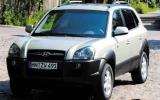Car-makers rarely do anything just for the hell of it. No move is motiveless and every act is loaded with the potential for spin.
With all this taken as a given, the news that Hyundai had chosen Latvia as the launch venue for the new Tucson SUV caused some head-scratching. Eastern Europe is about as far removed as you can get from the sun-drenched venues that manufacturers normally choose to introduce hacks to their latest models.
Yet all became clear in the press conference, and it was a lot less subtle than I was expecting. As the newest member of the EU, Latvia reckons its future success is best served by becoming a big player in Europe. And so does Hyundai. In fact, it’s hard to think of a more ambitious car manufacturer than the Korean outfit.
Already the world’s seventh biggest maker of cars, it wants to supplant Daimler Chrysler and PSA and hit the top five by 2007. And it sees Euro-friendly cars like the new Tucson as key to spearheading this future upsurge.
Enough of the corporate issues; just where exactly does the Tucson fit into the current market? Its proportions and styling tell you everything you need to know. It’s another alternative to the sub-£20k small SUV set that already includes the Toyota RAV4, Nissan X-trail, Mitsubishi Shogun Pinin, Honda CR-V and the cheaper members of the Land Rover Freelander line-up. The new car also sits below Hyundai’s existing off-roaders, the Santa Fé and Terracan.
nd you could see it treading on the toes of internal and external rivals when it goes on sale in August, with competitive pricing from £15,000 to £18,000 and a choice of three engines, all familiar from other Hyundai models and all Euro4 compliant: 140bhp 2.0-litre and 173bhp 2.7-litre V6 petrols, and a 110bhp 2.0-litre common-rail turbodiesel.
Normally front-wheel drive, the Tucson’s torque-sensing transmission diverts power to the rear wheels when it’s needed, and the car can be locked in four-wheel drive via a dash-mounted switch.
In the past, Hyundai has struggled to compete dynamically with its rivals. The fact that the Tucson – along with the next Sportage from sister company Kia – shares a platform with the mediocre Elantra should ring a few warning bells.
On the road, those bells get a lot louder. Latvian roads are badly scarred, but no worse than some British highways. Which means that the way the Tucson behaved on the roads around Riga should be a good reflection of how it will behave in the UK, and it’s not looking good.
Fact is, the good containment of body roll through bends means poor ride quality. There’s a distinct choppiness over rucked-up tarmac, but by far its worst characteristic is the way it builds up a pogo-ing motion over undulating roads, failing to keep vertical movement in check and then crashing down when encountering even modest surface pockmarks.
ronically, these characteristics made it a decent companion over the unmetalled roads (with much worse surfaces) we occasionally came across, but unless you spend most of your time on dirt and gravel it’s going to be unacceptably uncomfortable.
Other aspects of the Tucson’s refinement are also dubious. Even at modest speeds it throws up vibration and road roar into the cabin, and by the time you’ve reached motorway pace the cacophony is augmented by wind whistle from the A-pillars and roof rails.
















Add your comment